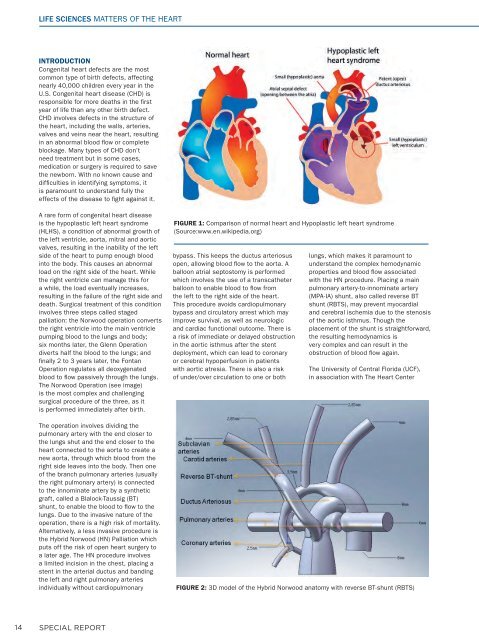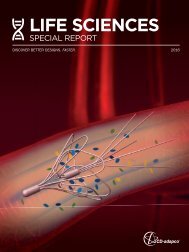Life science special report 161215 IY opt
Create successful ePaper yourself
Turn your PDF publications into a flip-book with our unique Google optimized e-Paper software.
LIFE SCIENCES MATTERS OF THE HEART<br />
INTRODUCTION<br />
Congenital heart defects are the most<br />
common type of birth defects, affecting<br />
nearly 40,000 children every year in the<br />
U.S. Congenital heart disease (CHD) is<br />
responsible for more deaths in the fi rst<br />
year of life than any other birth defect.<br />
CHD involves defects in the structure of<br />
the heart, including the walls, arteries,<br />
valves and veins near the heart, resulting<br />
in an abnormal blood fl ow or complete<br />
blockage. Many types of CHD don’t<br />
need treatment but in some cases,<br />
medication or surgery is required to save<br />
the newborn. With no known cause and<br />
diffi culties in identifying symptoms, it<br />
is paramount to understand fully the<br />
effects of the disease to fi ght against it.<br />
A rare form of congenital heart disease<br />
is the hypoplastic left heart syndrome<br />
(HLHS), a condition of abnormal growth of<br />
the left ventricle, aorta, mitral and aortic<br />
valves, resulting in the inability of the left<br />
side of the heart to pump enough blood<br />
into the body. This causes an abnormal<br />
load on the right side of the heart. While<br />
the right ventricle can manage this for<br />
a while, the load eventually increases,<br />
resulting in the failure of the right side and<br />
death. Surgical treatment of this condition<br />
involves three steps called staged<br />
palliation: the Norwood operation converts<br />
the right ventricle into the main ventricle<br />
pumping blood to the lungs and body;<br />
six months later, the Glenn Operation<br />
diverts half the blood to the lungs; and<br />
fi nally 2 to 3 years later, the Fontan<br />
Operation regulates all deoxygenated<br />
blood to fl ow passively through the lungs.<br />
The Norwood Operation (see image)<br />
is the most complex and challenging<br />
surgical procedure of the three, as it<br />
is performed immediately after birth.<br />
The operation involves dividing the<br />
pulmonary artery with the end closer to<br />
the lungs shut and the end closer to the<br />
heart connected to the aorta to create a<br />
new aorta, through which blood from the<br />
right side leaves into the body. Then one<br />
of the branch pulmonary arteries (usually<br />
the right pulmonary artery) is connected<br />
to the innominate artery by a synthetic<br />
graft, called a Blalock-Taussig (BT)<br />
shunt, to enable the blood to fl ow to the<br />
lungs. Due to the invasive nature of the<br />
operation, there is a high risk of mortality.<br />
Alternatively, a less invasive procedure is<br />
the Hybrid Norwood (HN) Palliation which<br />
puts off the risk of open heart surgery to<br />
a later age. The HN procedure involves<br />
a limited incision in the chest, placing a<br />
stent in the arterial ductus and banding<br />
the left and right pulmonary arteries<br />
individually without cardiopulmonary<br />
FIGURE 1: Comparison of normal heart and Hypoplastic left heart syndrome<br />
(Source:www.en.wikipedia.org)<br />
bypass. This keeps the ductus arteriosus<br />
open, allowing blood fl ow to the aorta. A<br />
balloon atrial septostomy is performed<br />
which involves the use of a transcatheter<br />
balloon to enable blood to fl ow from<br />
the left to the right side of the heart.<br />
This procedure avoids cardiopulmonary<br />
bypass and circulatory arrest which may<br />
improve survival, as well as neurologic<br />
and cardiac functional outcome. There is<br />
a risk of immediate or delayed obstruction<br />
in the aortic isthmus after the stent<br />
deployment, which can lead to coronary<br />
or cerebral hypoperfusion in patients<br />
with aortic atresia. There is also a risk<br />
of under/over circulation to one or both<br />
lungs, which makes it paramount to<br />
understand the complex hemodynamic<br />
properties and blood fl ow associated<br />
with the HN procedure. Placing a main<br />
pulmonary artery-to-innominate artery<br />
(MPA-IA) shunt, also called reverse BT<br />
shunt (RBTS), may prevent myocardial<br />
and cerebral ischemia due to the stenosis<br />
of the aortic isthmus. Though the<br />
placement of the shunt is straightforward,<br />
the resulting hemodynamics is<br />
very complex and can result in the<br />
obstruction of blood fl ow again.<br />
The University of Central Florida (UCF),<br />
in association with The Heart Center<br />
FIGURE 2: 3D model of the Hybrid Norwood anatomy with reverse BT-shunt (RBTS)<br />
14 SPECIAL REPORT



